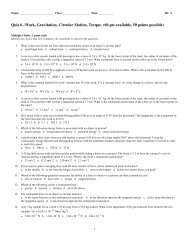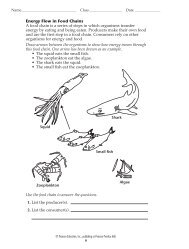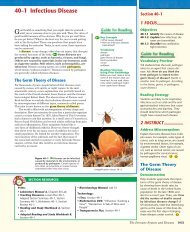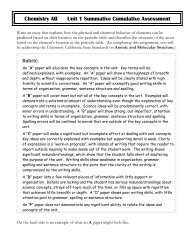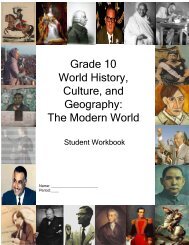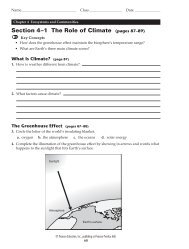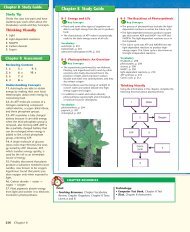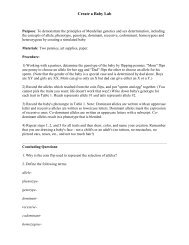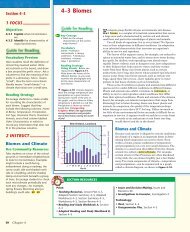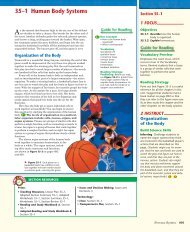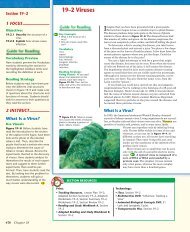ExamView - ICS--Quiz 1.tst
ExamView - ICS--Quiz 1.tst
ExamView - ICS--Quiz 1.tst
You also want an ePaper? Increase the reach of your titles
YUMPU automatically turns print PDFs into web optimized ePapers that Google loves.
Name: ________________________ Class: ___________________ Date: __________ID: A<strong>ICS</strong>--<strong>Quiz</strong> 1Multiple ChoiceIdentify the choice that best completes the statement or answers the question.1. Which of the following descriptions about the organization of an ecosystem is correct?a. Communities make up species, which make up populations.b. Populations make up species, which make up communities.c. Species make up communities, which make up populations.d. Species are grouped in populations, which make up communities.2. The simplest grouping of more than one kind of organism in the biosphere is a(an)a. population. c. ecosystem.b. community. d. species.3. Which ecological inquiry method is an ecologist using when he or she enters an area periodically to count thepopulation numbers of a certain species?a. questioning c. experimentingb. observing d. modelingFigure 3-14. The algae at the beginning of the food chain in Figure 3-1 area. consumers. c. producers.b. decomposers. d. heterotrophs.5. An organism that uses energy to produce its own food supply from inorganic compounds is called a(an)a. heterotroph. c. detritivore.b. consumer. d. autotroph.6. Which of the following organisms does NOT require sunlight to live?a. chemosynthetic bacteria c. treesb. algae d. photosynthetic bacteria7. What animals eat both producers and consumers?a. herbivores c. chemotrophsb. omnivores d. autotrophs8. A snake that eats a frog that has eaten an insect that fed on a plant is aa. first-level producer. c. second-level producer.b. first-level consumer. d. third-level consumer.1
Name: ________________________ID: AFigure 3–29. The trophic levels in Figure 3-2 illustratea. the relative amount of energy.b. the amount of living organic matter.c. the relative number of individual organisms.d. that producers outnumber first-level consumers.10. The branch of biology dealing with interactions among organisms and between organisms and their environment iscalleda. economy. c. recycling.b. modeling. d. ecology.11. What is the combined portions of Earth called in which all living things exist?a. biome c. ecosystemb. community d. biosphere12. Green plants area. producers. c. herbivores.b. consumers. d. omnivores.13. What is the original source of almost all the energy in most ecosystems?a. carbohydrates c. waterb. sunlight d. carbon14. An organism that cannot make its own food is called a(an)a. heterotroph. c. autotroph.b. chemotroph. d. producer.15. Organisms that obtain nutrients by breaking down dead and decaying plants and animals are calleda. decomposers. c. autotrophs.b. omnivores. d. producers.2
Name: ________________________ID: A16. What is an organism that feeds only on plants called?a. carnivore c. omnivoreb. herbivore d. detritivore17. All the interconnected feeding relationships in an ecosystem make up a fooda. interaction. c. network.b. chain. d. web.18. Which is a biotic factor that affects the size of a population in a specific ecosystem?a. average temperature of the ecosystemb. type of soil in the ecosystemc. number and kinds of predators in the ecosystemd. concentration of oxygen in the ecosystem19. Each of the following is an abiotic factor in the environment EXCEPTa. plant life. c. rainfall.b. soil type. d. temperature.Short AnswerFigure 3–220. Describe the flow of energy to the owl in Figure 3-2 if the tree provides 1500 calories of energy to the insects.Essay21. How does a food web differ from a food chain?3
Name: ________________________ID: AOther22. Draw a Food Web that shows the feeding relationships and flow of energy between organisms living in a grasslandecosystem. Include in your food web, all the following:1) organisms that represent at least 4 trophic levels2) clearly identify each trophic level3) identify and label one Food Chain that includes at least 4 organisms23. Using a Food Chain, Food Web, or Energy Pyramind, explain the 10% Rule for Energy Transfer betweenorganisms of different trophic levels. Include in your explanation why energy is lost moving from lower to highertrophic levels.4
ID: A<strong>ICS</strong>--<strong>Quiz</strong> 1Answer SectionMULTIPLE CHOICE1. ANS: D PTS: 1 REF: p. 642. ANS: B PTS: 1 REF: p. 643. ANS: B PTS: 1 REF: p. 654. ANS: C PTS: 1 REF: p. 675. ANS: D PTS: 1 REF: p. 676. ANS: A PTS: 1 REF: p. 687. ANS: B PTS: 1 REF: p. 698. ANS: D PTS: 1 REF: p. 709. ANS: C PTS: 1 REF: p. 7010. ANS: D PTS: 1 REF: p. 6311. ANS: D PTS: 1 REF: p. 6312. ANS: A PTS: 1 REF: p. 6713. ANS: B PTS: 1 REF: p. 6714. ANS: A PTS: 1 REF: p. 6815. ANS: A PTS: 1 REF: p. 6916. ANS: B PTS: 1 REF: p. 6917. ANS: D PTS: 1 REF: p. 7018. ANS: C PTS: 1 REF: p. 9019. ANS: A PTS: 1 REF: p. 90SHORT ANSWER20. ANS:The insects would provide 10 percent (one tenth) of 1500 calories, or 150 calories, of energy to the shrews. Theshrews would provide one tenth of 150 calories, or 15 calories to the owl.PTS: 1 REF: p. 72ESSAY21. ANS:A food chain is a series of steps in which organisms transfer energy by eating and being eaten. A food web is afeeding relationship among the various organisms in an ecosystem that forms a network of complex interactions. Afood web links together all the food chains in an ecosystem.PTS: 1 REF: p. 69 | p. 701
ID: AOTHER22. ANS:Response variesPTS: 123. ANS:Answers vary.PTS: 12
Name: ________________________ Class: ___________________ Date: __________ID: B<strong>ICS</strong>--<strong>Quiz</strong> 1Multiple ChoiceIdentify the choice that best completes the statement or answers the question.1. A snake that eats a frog that has eaten an insect that fed on a plant is aa. first-level producer. c. second-level producer.b. first-level consumer. d. third-level consumer.2. Which of the following descriptions about the organization of an ecosystem is correct?a. Communities make up species, which make up populations.b. Populations make up species, which make up communities.c. Species make up communities, which make up populations.d. Species are grouped in populations, which make up communities.3. What is an organism that feeds only on plants called?a. carnivore c. omnivoreb. herbivore d. detritivore4. Which of the following organisms does NOT require sunlight to live?a. chemosynthetic bacteria c. treesb. algae d. photosynthetic bacteriaFigure 3–25. The trophic levels in Figure 3-2 illustratea. the relative amount of energy.b. the amount of living organic matter.c. the relative number of individual organisms.d. that producers outnumber first-level consumers.1
Name: ________________________ID: B6. The branch of biology dealing with interactions among organisms and between organisms and their environment iscalleda. economy. c. recycling.b. modeling. d. ecology.7. An organism that uses energy to produce its own food supply from inorganic compounds is called a(an)a. heterotroph. c. detritivore.b. consumer. d. autotroph.8. An organism that cannot make its own food is called a(an)a. heterotroph. c. autotroph.b. chemotroph. d. producer.9. Each of the following is an abiotic factor in the environment EXCEPTa. plant life. c. rainfall.b. soil type. d. temperature.10. Green plants area. producers. c. herbivores.b. consumers. d. omnivores.11. What animals eat both producers and consumers?a. herbivores c. chemotrophsb. omnivores d. autotrophs12. All the interconnected feeding relationships in an ecosystem make up a fooda. interaction. c. network.b. chain. d. web.13. Which ecological inquiry method is an ecologist using when he or she enters an area periodically to count thepopulation numbers of a certain species?a. questioning c. experimentingb. observing d. modelingFigure 3-114. The algae at the beginning of the food chain in Figure 3-1 area. consumers. c. producers.b. decomposers. d. heterotrophs.15. The simplest grouping of more than one kind of organism in the biosphere is a(an)a. population. c. ecosystem.b. community. d. species.16. Which is a biotic factor that affects the size of a population in a specific ecosystem?a. average temperature of the ecosystemb. type of soil in the ecosystemc. number and kinds of predators in the ecosystemd. concentration of oxygen in the ecosystem2
Name: ________________________ID: B17. What is the combined portions of Earth called in which all living things exist?a. biome c. ecosystemb. community d. biosphere18. What is the original source of almost all the energy in most ecosystems?a. carbohydrates c. waterb. sunlight d. carbon19. Organisms that obtain nutrients by breaking down dead and decaying plants and animals are calleda. decomposers. c. autotrophs.b. omnivores. d. producers.Short AnswerFigure 3–220. Describe the flow of energy to the owl in Figure 3-2 if the tree provides 1500 calories of energy to the insects.Essay21. How does a food web differ from a food chain?Other22. Using a Food Chain, Food Web, or Energy Pyramind, explain the 10% Rule for Energy Transfer betweenorganisms of different trophic levels. Include in your explanation why energy is lost moving from lower to highertrophic levels.3
Name: ________________________ID: B23. Draw a Food Web that shows the feeding relationships and flow of energy between organisms living in a grasslandecosystem. Include in your food web, all the following:1) organisms that represent at least 4 trophic levels2) clearly identify each trophic level3) identify and label one Food Chain that includes at least 4 organisms4
ID: B<strong>ICS</strong>--<strong>Quiz</strong> 1Answer SectionMULTIPLE CHOICE1. ANS: D PTS: 1 REF: p. 702. ANS: D PTS: 1 REF: p. 643. ANS: B PTS: 1 REF: p. 694. ANS: A PTS: 1 REF: p. 685. ANS: C PTS: 1 REF: p. 706. ANS: D PTS: 1 REF: p. 637. ANS: D PTS: 1 REF: p. 678. ANS: A PTS: 1 REF: p. 689. ANS: A PTS: 1 REF: p. 9010. ANS: A PTS: 1 REF: p. 6711. ANS: B PTS: 1 REF: p. 6912. ANS: D PTS: 1 REF: p. 7013. ANS: B PTS: 1 REF: p. 6514. ANS: C PTS: 1 REF: p. 6715. ANS: B PTS: 1 REF: p. 6416. ANS: C PTS: 1 REF: p. 9017. ANS: D PTS: 1 REF: p. 6318. ANS: B PTS: 1 REF: p. 6719. ANS: A PTS: 1 REF: p. 69SHORT ANSWER20. ANS:The insects would provide 10 percent (one tenth) of 1500 calories, or 150 calories, of energy to the shrews. Theshrews would provide one tenth of 150 calories, or 15 calories to the owl.PTS: 1 REF: p. 72ESSAY21. ANS:A food chain is a series of steps in which organisms transfer energy by eating and being eaten. A food web is afeeding relationship among the various organisms in an ecosystem that forms a network of complex interactions. Afood web links together all the food chains in an ecosystem.PTS: 1 REF: p. 69 | p. 701
ID: BOTHER22. ANS:Answers vary.PTS: 123. ANS:Response variesPTS: 12
Name: ________________________ID: C13. What is the original source of almost all the energy in most ecosystems?a. carbohydrates c. waterb. sunlight d. carbonFigure 3–214. The trophic levels in Figure 3-2 illustratea. the relative amount of energy.b. the amount of living organic matter.c. the relative number of individual organisms.d. that producers outnumber first-level consumers.15. What animals eat both producers and consumers?a. herbivores c. chemotrophsb. omnivores d. autotrophs16. A snake that eats a frog that has eaten an insect that fed on a plant is aa. first-level producer. c. second-level producer.b. first-level consumer. d. third-level consumer.17. Which of the following descriptions about the organization of an ecosystem is correct?a. Communities make up species, which make up populations.b. Populations make up species, which make up communities.c. Species make up communities, which make up populations.d. Species are grouped in populations, which make up communities.18. What is an organism that feeds only on plants called?a. carnivore c. omnivoreb. herbivore d. detritivore2
Name: ________________________ID: COther22. Using a Food Chain, Food Web, or Energy Pyramind, explain the 10% Rule for Energy Transfer betweenorganisms of different trophic levels. Include in your explanation why energy is lost moving from lower to highertrophic levels.23. Draw a Food Web that shows the feeding relationships and flow of energy between organisms living in a grasslandecosystem. Include in your food web, all the following:1) organisms that represent at least 4 trophic levels2) clearly identify each trophic level3) identify and label one Food Chain that includes at least 4 organisms4
ID: C<strong>ICS</strong>--<strong>Quiz</strong> 1Answer SectionMULTIPLE CHOICE1. ANS: B PTS: 1 REF: p. 652. ANS: A PTS: 1 REF: p. 683. ANS: A PTS: 1 REF: p. 694. ANS: B PTS: 1 REF: p. 645. ANS: C PTS: 1 REF: p. 906. ANS: A PTS: 1 REF: p. 677. ANS: D PTS: 1 REF: p. 638. ANS: D PTS: 1 REF: p. 639. ANS: D PTS: 1 REF: p. 7010. ANS: A PTS: 1 REF: p. 6811. ANS: A PTS: 1 REF: p. 9012. ANS: D PTS: 1 REF: p. 6713. ANS: B PTS: 1 REF: p. 6714. ANS: C PTS: 1 REF: p. 7015. ANS: B PTS: 1 REF: p. 6916. ANS: D PTS: 1 REF: p. 7017. ANS: D PTS: 1 REF: p. 6418. ANS: B PTS: 1 REF: p. 6919. ANS: C PTS: 1 REF: p. 67SHORT ANSWER20. ANS:The insects would provide 10 percent (one tenth) of 1500 calories, or 150 calories, of energy to the shrews. Theshrews would provide one tenth of 150 calories, or 15 calories to the owl.PTS: 1 REF: p. 72ESSAY21. ANS:A food chain is a series of steps in which organisms transfer energy by eating and being eaten. A food web is afeeding relationship among the various organisms in an ecosystem that forms a network of complex interactions. Afood web links together all the food chains in an ecosystem.PTS: 1 REF: p. 69 | p. 701
ID: COTHER22. ANS:Answers vary.PTS: 123. ANS:Response variesPTS: 12
Name: ________________________ Class: ___________________ Date: __________ID: D<strong>ICS</strong>--<strong>Quiz</strong> 1Multiple ChoiceIdentify the choice that best completes the statement or answers the question.1. Which is a biotic factor that affects the size of a population in a specific ecosystem?a. average temperature of the ecosystemb. type of soil in the ecosystemc. number and kinds of predators in the ecosystemd. concentration of oxygen in the ecosystem2. Organisms that obtain nutrients by breaking down dead and decaying plants and animals are calleda. decomposers. c. autotrophs.b. omnivores. d. producers.Figure 3-13. The algae at the beginning of the food chain in Figure 3-1 area. consumers. c. producers.b. decomposers. d. heterotrophs.4. Each of the following is an abiotic factor in the environment EXCEPTa. plant life. c. rainfall.b. soil type. d. temperature.5. Green plants area. producers. c. herbivores.b. consumers. d. omnivores.6. A snake that eats a frog that has eaten an insect that fed on a plant is aa. first-level producer. c. second-level producer.b. first-level consumer. d. third-level consumer.7. An organism that cannot make its own food is called a(an)a. heterotroph. c. autotroph.b. chemotroph. d. producer.1
Name: ________________________ID: DFigure 3–28. The trophic levels in Figure 3-2 illustratea. the relative amount of energy.b. the amount of living organic matter.c. the relative number of individual organisms.d. that producers outnumber first-level consumers.9. The branch of biology dealing with interactions among organisms and between organisms and their environment iscalleda. economy. c. recycling.b. modeling. d. ecology.10. What is an organism that feeds only on plants called?a. carnivore c. omnivoreb. herbivore d. detritivore11. What is the original source of almost all the energy in most ecosystems?a. carbohydrates c. waterb. sunlight d. carbon12. An organism that uses energy to produce its own food supply from inorganic compounds is called a(an)a. heterotroph. c. detritivore.b. consumer. d. autotroph.13. What is the combined portions of Earth called in which all living things exist?a. biome c. ecosystemb. community d. biosphere14. All the interconnected feeding relationships in an ecosystem make up a fooda. interaction. c. network.b. chain. d. web.2
Name: ________________________ID: D15. Which of the following descriptions about the organization of an ecosystem is correct?a. Communities make up species, which make up populations.b. Populations make up species, which make up communities.c. Species make up communities, which make up populations.d. Species are grouped in populations, which make up communities.16. The simplest grouping of more than one kind of organism in the biosphere is a(an)a. population. c. ecosystem.b. community. d. species.17. Which ecological inquiry method is an ecologist using when he or she enters an area periodically to count thepopulation numbers of a certain species?a. questioning c. experimentingb. observing d. modeling18. Which of the following organisms does NOT require sunlight to live?a. chemosynthetic bacteria c. treesb. algae d. photosynthetic bacteria19. What animals eat both producers and consumers?a. herbivores c. chemotrophsb. omnivores d. autotrophsShort AnswerFigure 3–220. Describe the flow of energy to the owl in Figure 3-2 if the tree provides 1500 calories of energy to the insects.3
Name: ________________________ID: DEssay21. How does a food web differ from a food chain?Other22. Using a Food Chain, Food Web, or Energy Pyramind, explain the 10% Rule for Energy Transfer betweenorganisms of different trophic levels. Include in your explanation why energy is lost moving from lower to highertrophic levels.23. Draw a Food Web that shows the feeding relationships and flow of energy between organisms living in a grasslandecosystem. Include in your food web, all the following:1) organisms that represent at least 4 trophic levels2) clearly identify each trophic level3) identify and label one Food Chain that includes at least 4 organisms4
ID: D<strong>ICS</strong>--<strong>Quiz</strong> 1Answer SectionMULTIPLE CHOICE1. ANS: C PTS: 1 REF: p. 902. ANS: A PTS: 1 REF: p. 693. ANS: C PTS: 1 REF: p. 674. ANS: A PTS: 1 REF: p. 905. ANS: A PTS: 1 REF: p. 676. ANS: D PTS: 1 REF: p. 707. ANS: A PTS: 1 REF: p. 688. ANS: C PTS: 1 REF: p. 709. ANS: D PTS: 1 REF: p. 6310. ANS: B PTS: 1 REF: p. 6911. ANS: B PTS: 1 REF: p. 6712. ANS: D PTS: 1 REF: p. 6713. ANS: D PTS: 1 REF: p. 6314. ANS: D PTS: 1 REF: p. 7015. ANS: D PTS: 1 REF: p. 6416. ANS: B PTS: 1 REF: p. 6417. ANS: B PTS: 1 REF: p. 6518. ANS: A PTS: 1 REF: p. 6819. ANS: B PTS: 1 REF: p. 69SHORT ANSWER20. ANS:The insects would provide 10 percent (one tenth) of 1500 calories, or 150 calories, of energy to the shrews. Theshrews would provide one tenth of 150 calories, or 15 calories to the owl.PTS: 1 REF: p. 72ESSAY21. ANS:A food chain is a series of steps in which organisms transfer energy by eating and being eaten. A food web is afeeding relationship among the various organisms in an ecosystem that forms a network of complex interactions. Afood web links together all the food chains in an ecosystem.PTS: 1 REF: p. 69 | p. 701
ID: DOTHER22. ANS:Answers vary.PTS: 123. ANS:Response variesPTS: 12



